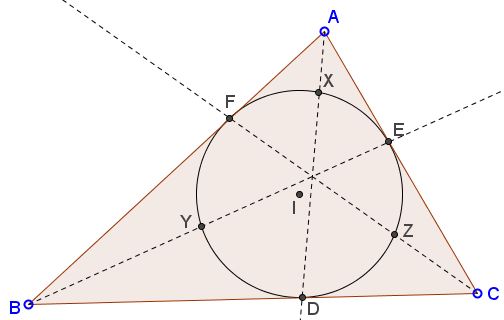Third Unusual Identity in Triangle
Let $D,E,F$ denote the points of tangency of the incircle $(I)$ on the sides $BC,AC,AB$ of $\Delta ABC.$ Define $X,Y,Z$ as the points of intersection of $(I)$ with $AD,BE,CF,$ respectively.

Prove that
$\begin{align}\displaystyle \frac{1}{\frac{AX}{XD}+\frac{1}{4}}+\frac{1}{\frac{BY}{YE}+\frac{1}{4}}+\frac{1}{\frac{CZ}{ZF}+\frac{1}{4}}=4. \end{align}$
Proof
We know that $AF = AE = p - a,$ $BD = BF = p - b,$ $CE = CD = p - c.$ Set $p - a = x,$ $p - b = y$ and $p - c = z$ such that $a = y + z,$ $b = z + x$ and $c = x + y.$
By the Power of a point theorem (applied at $A),$ $AX \cdot AD = AF^2.$ From here, $\displaystyle \frac{AX}{XD}=\frac{AD^{2}-X^{2}}{X^{2}}.$
By Stewart's theorem for the cevian $AD$ in $\Delta ABC,$
$AD^{2}(y+z)+yz(y+z)=(z+x)^{2}y+(x+y)^{2}z$
wherefrom $\displaystyle AD^{2}=x^{2}+\frac{4xyq}{y+z},$ or $\displaystyle AD^{2}-x^{2}=\frac{4xyq}{y+z}$. Combining this with the earlier identity,
$\displaystyle\frac{AX}{XD}=\frac{x^{2}}{AD^{2}-x^{2}}=\frac{x(y+z)}{4yz},$
which is equivalent to
$\displaystyle\frac{AX}{XD}+\frac{1}{4}=\frac{xy+yz+zx}{4yz}.$
In other words,
$\displaystyle\frac{1}{\frac{AX}{XD}+\frac{1}{4}}=\frac{4yz}{xy+yz+zx}.$
Similarly, $\displaystyle\frac{1}{\frac{BY}{YE}+\frac{1}{4}}=\frac{4xz}{xy+yz+zx}$ and $\displaystyle\frac{1}{\frac{CZ}{ZF}+\frac{1}{4}}=\frac{4xy}{xy+yz+zx}.$ Adding the three up gives the desired result.
Acknowledgment
The problem has been mailed to me by Leo Giugiuc along with the above proof. Leo credits the identity to Van Khea. The above joins two earlier identities by Van Khea: (1) and (2).
|Contact| |Front page| |Contents| |Geometry|
Copyright © 1996-2018 Alexander Bogomolny
73579256
